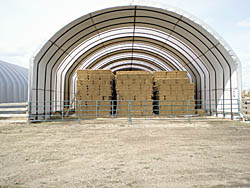
By developing a system to bend recycled oilfield tubing, Jim Klys and his neighbor, Richard Schmidt, have successfully constructed their own canvas-covered hay sheds and storage buildings. The pair put up five buildings for themselves. They turned out so well they launched a business called Farmer Built Structures.
To bend pipe, the men pound a half-moon pattern of 2 7/8-in. steel fence posts into the ground, and then use a tractor to bend the pipe around the half circle by chaining one end to a fence post and pulling the other end around, using a long sling.
"There's no heating required, but the trick is in how you pull it, in order to get a consistent end product," Klys says. "Ours are such carbon copies that you could cover them with metal siding."
They buy the 2 7/8-in. dia. by 1/4-in. thick walled tubing in bulk. Lengths vary from 28 to 32 feet, and the men have to sort through it as some will inevitably be thin-walled or soft.
When they're ready to begin putting up the building, the pair drill 12-in. dia. post holes along the shed perimeter which are 3 to 4 ft. deep. Straight sections of 2 7/8-in. upright pipe are driven into the holes a further foot or two, and then they're cemented in, once the above-ground sections are all the same height.
"To make a good hay shed, the uprights should be 6 1/2 ft. above ground and spaced 6 ft. apart," Klys says. "Next, we use 8-in. sections of 2 3/8-in pipe as our connectors to set the arches on top of the uprights. The joints are all welded together and the arch sections have couplers on them that screw together."
One and 3/4-in. dia. pipes are welded every 10 ft. down the length of the building and serve as support ribs. A straight 2 7/8 ridge pole is welded along the top middle.
Klys and the crew installs 12.5-oz. canvas that comes with a 15-year warranty, and pipe pockets that run along each inside horizontal edge.
Using ropes thrown over the top of the building, they pull the canvas over from one side to the other.
Rachet winches that had been previously welded to the bottom of the perimeter uprights (about 6 in. above ground), are used in combination with seat belting to snug the canvas up tight -- but not drum tight. The outside base of the building is sealed up with a skirt made from either dirt or gravel.
"End walls for hay sheds are often made with slatted wood so air can still circulate, but for other purposes, the ends are closed in completely with either tarp, tin or wood," Klys says. "They can also be framed for overhead doors."
The men have built 42-ft. wide and 62-ft. wide sheds. They say 200 ft. is the maximum length that's practical for working with tarps.
"Three stacks of small square bales fit nicely in a 42-ft. wide shed, leaving room to walk down each side," he says. "The only disadvantage to using recycled materials is that we can't guarantee the engineering. Although there's always a risk that the building could collapse, we've put up over 80 of them now, and have never had any come down."
The custom built sheds take about four days to put up.
